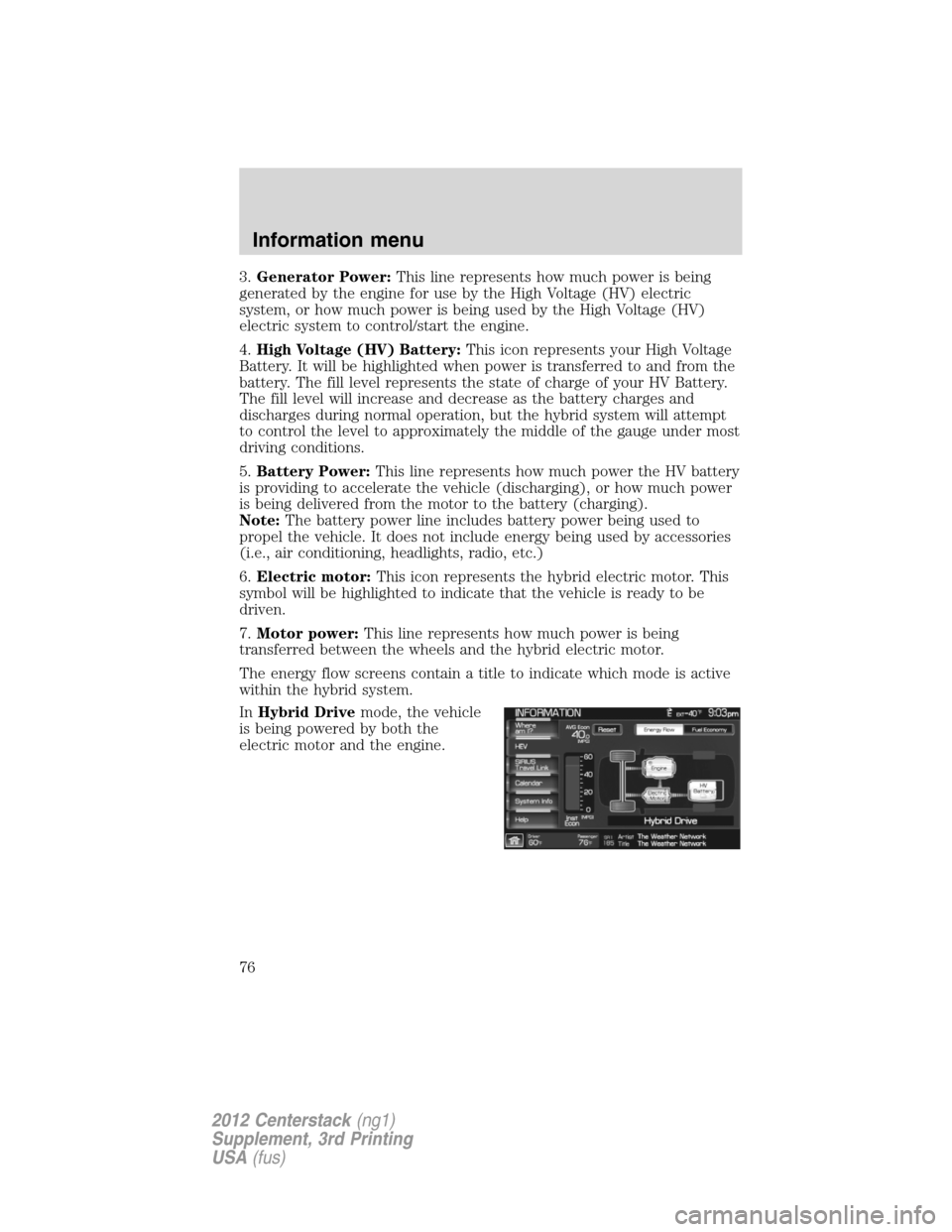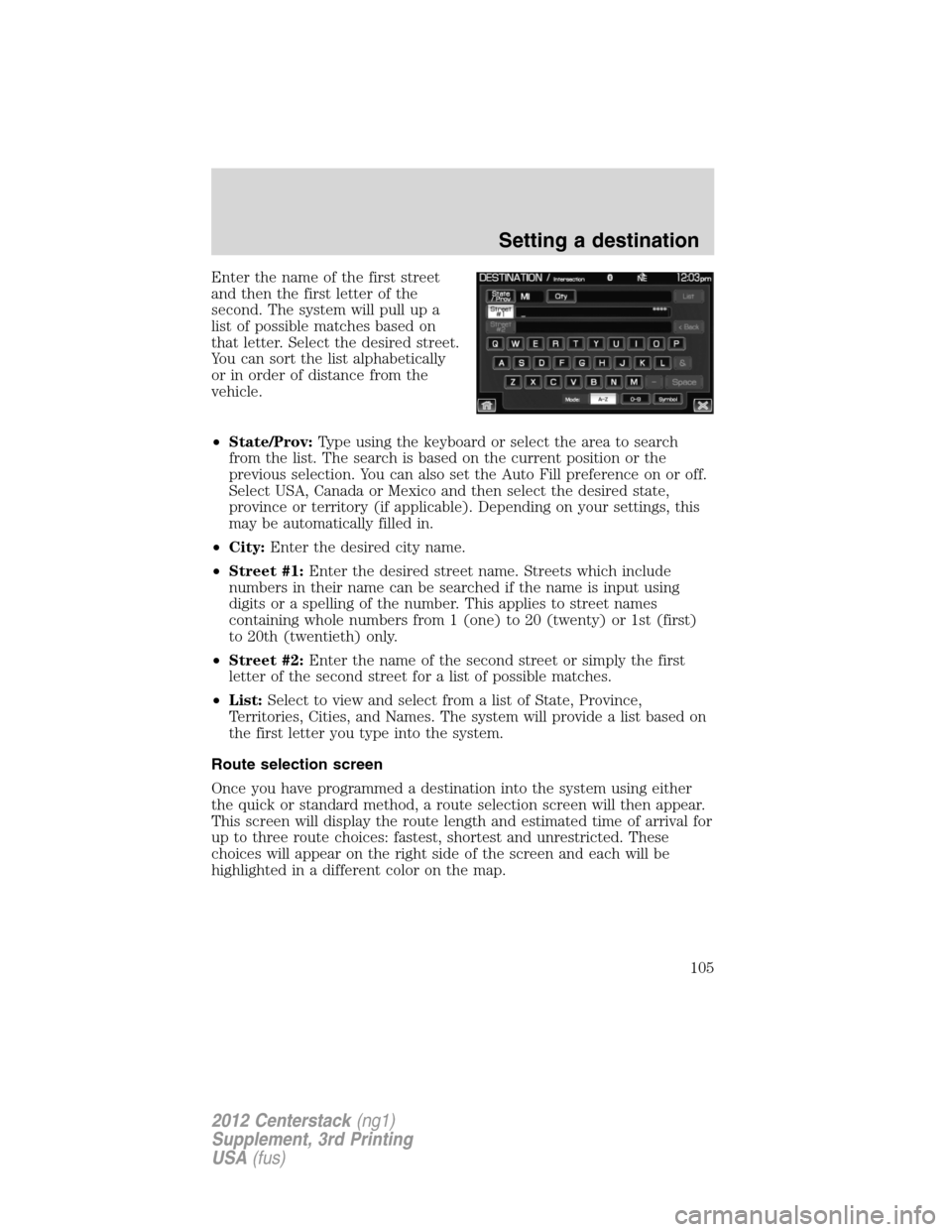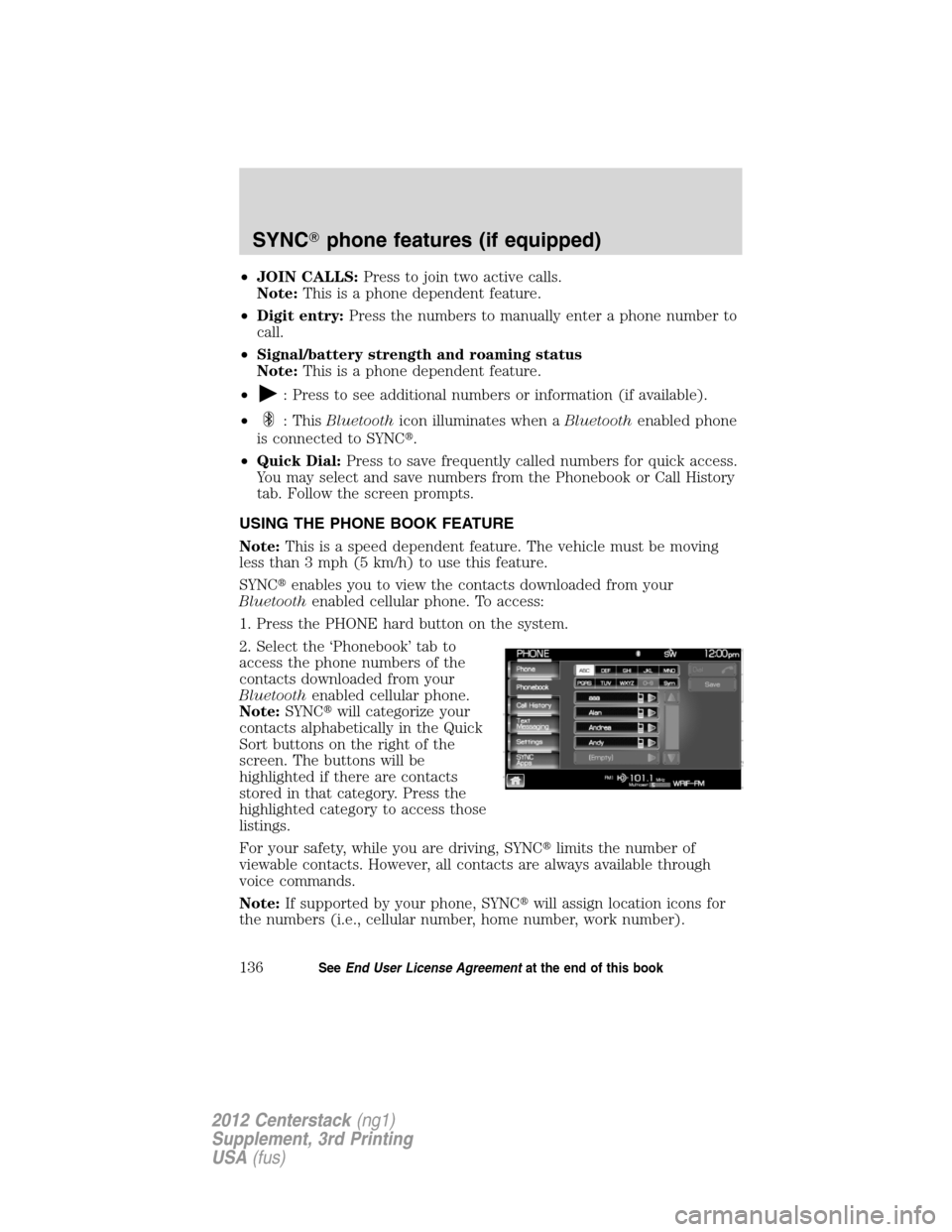Page 76 of 200

3.Generator Power:This line represents how much power is being
generated by the engine for use by the High Voltage (HV) electric
system, or how much power is being used by the High Voltage (HV)
electric system to control/start the engine.
4.High Voltage (HV) Battery:This icon represents your High Voltage
Battery. It will be highlighted when power is transferred to and from the
battery. The fill level represents the state of charge of your HV Battery.
The fill level will increase and decrease as the battery charges and
discharges during normal operation, but the hybrid system will attempt
to control the level to approximately the middle of the gauge under most
driving conditions.
5.Battery Power:This line represents how much power the HV battery
is providing to accelerate the vehicle (discharging), or how much power
is being delivered from the motor to the battery (charging).
Note:The battery power line includes battery power being used to
propel the vehicle. It does not include energy being used by accessories
(i.e., air conditioning, headlights, radio, etc.)
6.Electric motor:This icon represents the hybrid electric motor. This
symbol will be highlighted to indicate that the vehicle is ready to be
driven.
7.Motor power:This line represents how much power is being
transferred between the wheels and the hybrid electric motor.
The energy flow screens contain a title to indicate which mode is active
within the hybrid system.
InHybrid Drivemode, the vehicle
is being powered by both the
electric motor and the engine.
Information menu
76
2012 Centerstack(ng1)
Supplement, 3rd Printing
USA(fus)
Page 105 of 200

Enter the name of the first street
and then the first letter of the
second. The system will pull up a
list of possible matches based on
that letter. Select the desired street.
You can sort the list alphabetically
or in order of distance from the
vehicle.
•State/Prov:Type using the keyboard or select the area to search
from the list. The search is based on the current position or the
previous selection. You can also set the Auto Fill preference on or off.
Select USA, Canada or Mexico and then select the desired state,
province or territory (if applicable). Depending on your settings, this
may be automatically filled in.
•City:Enter the desired city name.
•Street #1:Enter the desired street name. Streets which include
numbers in their name can be searched if the name is input using
digits or a spelling of the number. This applies to street names
containing whole numbers from 1 (one) to 20 (twenty) or 1st (first)
to 20th (twentieth) only.
•Street #2:Enter the name of the second street or simply the first
letter of the second street for a list of possible matches.
•List:Select to view and select from a list of State, Province,
Territories, Cities, and Names. The system will provide a list based on
the first letter you type into the system.
Route selection screen
Once you have programmed a destination into the system using either
the quick or standard method, a route selection screen will then appear.
This screen will display the route length and estimated time of arrival for
up to three route choices: fastest, shortest and unrestricted. These
choices will appear on the right side of the screen and each will be
highlighted in a different color on the map.
Setting a destination
105
2012 Centerstack(ng1)
Supplement, 3rd Printing
USA(fus)
Page 113 of 200
Route guidance in incomplete mapped areas
There are some rural areas in the map database where roads have not
been fully verified. When the system is in route guidance mode, and the
navigation system encounters these incomplete mapped areas, the
system will alert you by:
•Announcing�Entering an area with incomplete map data, please follow
with caution�.
•Saying�with caution�in the first route guidance instruction before
each turn.
•Highlighting the route on the map in yellow.
•Highlighting the incomplete mapped streets in yellow on the turn list.
•Coloring the guidance arrows yellow.
Please drive using extra caution when driving in these areas as the
mapping information may be somewhat inaccurate.
Setting a destination
113
2012 Centerstack(ng1)
Supplement, 3rd Printing
USA(fus)
Page 136 of 200

•JOIN CALLS:Press to join two active calls.
Note:This is a phone dependent feature.
•Digit entry:Press the numbers to manually enter a phone number to
call.
•Signal/battery strength and roaming status
Note:This is a phone dependent feature.
•
: Press to see additional numbers or information (if available).
•
: ThisBluetoothicon illuminates when aBluetoothenabled phone
is connected to SYNC�.
•Quick Dial:Press to save frequently called numbers for quick access.
You may select and save numbers from the Phonebook or Call History
tab. Follow the screen prompts.
USING THE PHONE BOOK FEATURE
Note:This is a speed dependent feature. The vehicle must be moving
less than 3 mph (5 km/h) to use this feature.
SYNC�enables you to view the contacts downloaded from your
Bluetoothenabled cellular phone. To access:
1. Press the PHONE hard button on the system.
2. Select the ‘Phonebook’ tab to
access the phone numbers of the
contacts downloaded from your
Bluetoothenabled cellular phone.
Note:SYNC�will categorize your
contacts alphabetically in the Quick
Sort buttons on the right of the
screen. The buttons will be
highlighted if there are contacts
stored in that category. Press the
highlighted category to access those
listings.
For your safety, while you are driving, SYNC�limits the number of
viewable contacts. However, all contacts are always available through
voice commands.
Note:If supported by your phone, SYNC�will assign location icons for
the numbers (i.e., cellular number, home number, work number).
SYNC�phone features (if equipped)
136SeeEnd User License Agreementat the end of this book
2012 Centerstack(ng1)
Supplement, 3rd Printing
USA(fus)